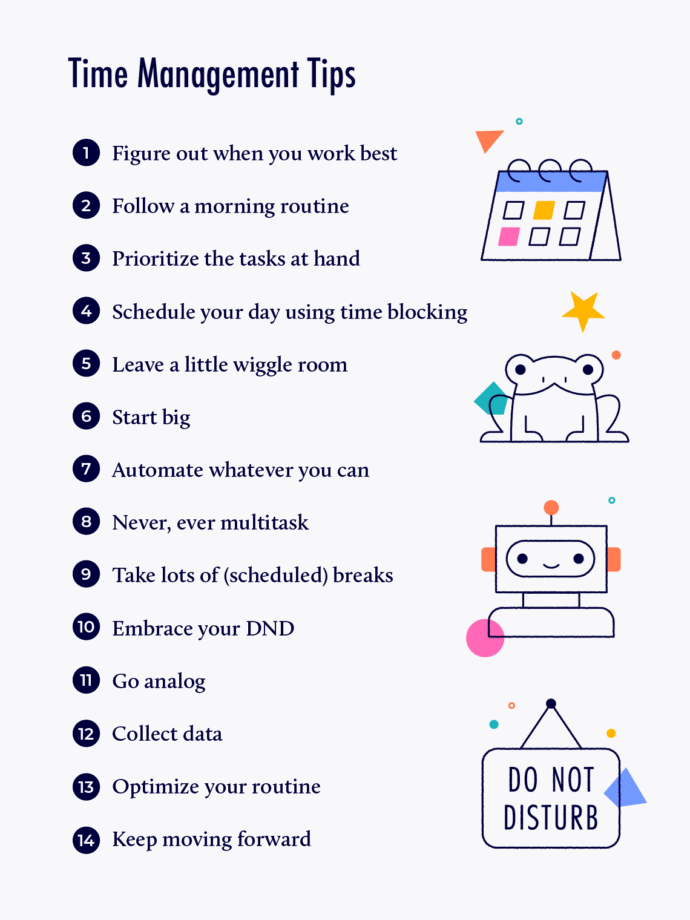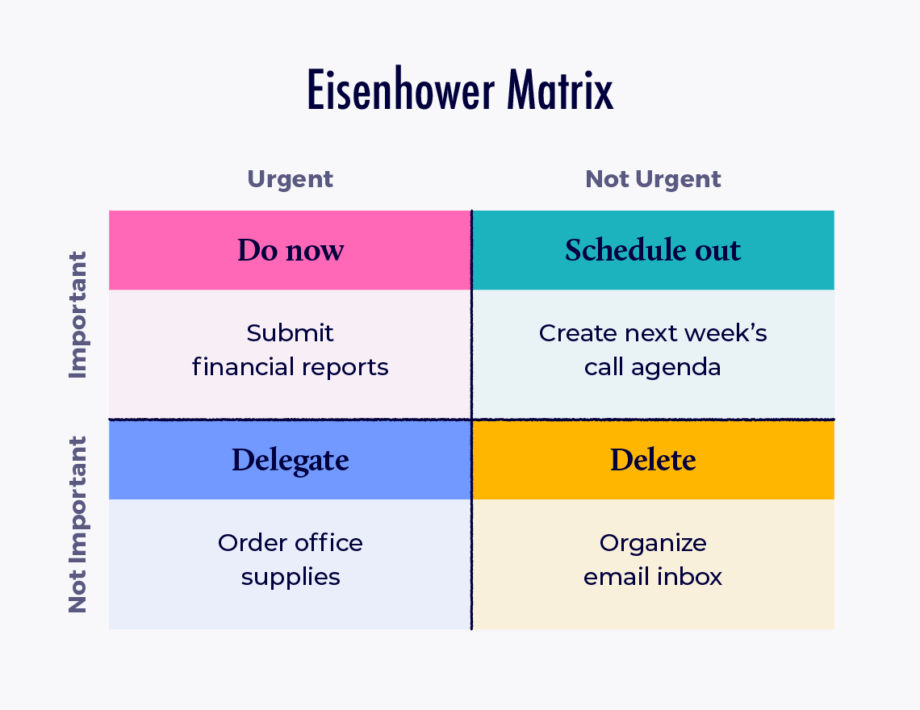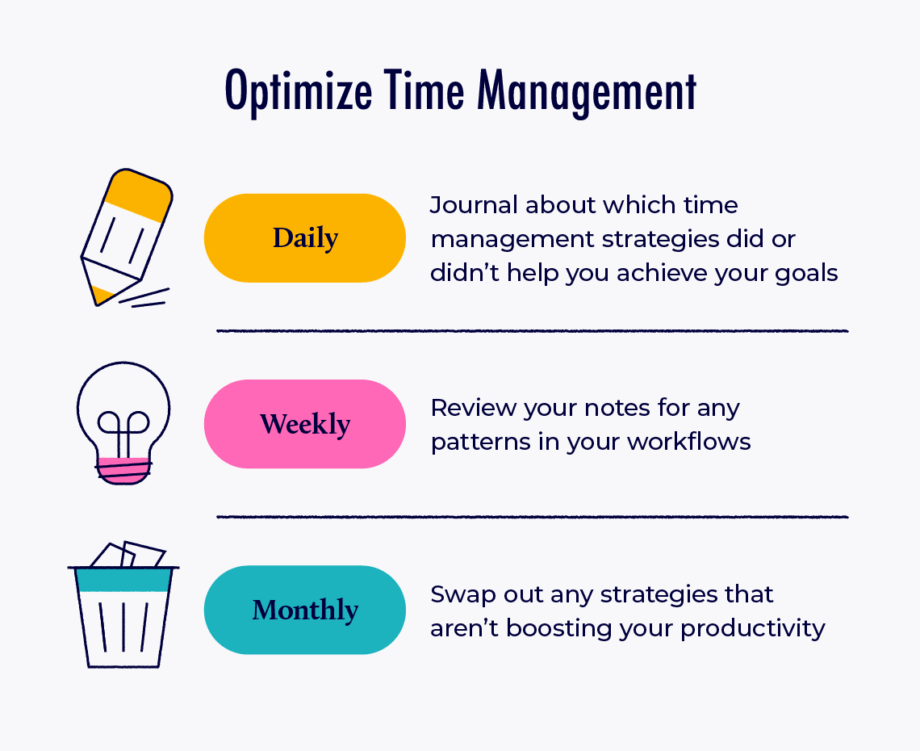Don’t we all wish there were more than 24 hours in a day?
While adding more hours to the day may be impossible, accomplishing 25% more in the time you do have isn’t as hard as you might think.
In fact, the average employee spends almost 3 hours of their 8-hour workday on nonwork-related activities.
That’s nearly two full work days a week — yikes!
And that doesn’t even account for additional work-related time sinks. Unproductive meetings. Responding to emails. Putting out other people’s fires. Social media rabbit holes.
Whether you’re a busy professional, an entrepreneur or a student, effectively managing your time can make all the difference in achieving your goals and living a more fulfilling life.
In this guide, I’ll explore 19 time management strategies to help you become more productive, efficient and fulfilled.
Let’s dive right in!
Key Takeaways
- Time management is a skill, and it takes time and practice to find what works for you.
- You’re not the only one who needs better time management strategies — only 20% of people feel their work is under control each day.
- Take breaks and build cushion time into your schedule so unforeseen obstacles don’t disrupt your week.
- Make changes when a new strategy isn’t working for you.

1. Figure Out When You Work Best
It’s easy to fall into daily routines that don’t work for you. Sure, a nine-to-five work schedule is the standard, but it doesn’t work for everyone.
Some people wake up bright, bushy-tailed and ready to tackle anything by 6 a.m. Others struggle to leave bed before 10.
Odds are, your productivity will skyrocket if you work with your body’s natural rhythm instead of fighting it.
Pay attention to how you feel in the morning, afternoon and night, and notice how your motivation changes throughout the day.
Many people identify with one of the four sleep chronotypes to describe their ideal workflow:
- Lion: Most productive in the early morning
- Bear: Most productive in the mid-morning to afternoon
- Dolphin: Most productive in the afternoon
- Wolf: Most productive late at night
Take note of how you feel throughout the day and when you focus best.
Do you wake up ready to tackle your biggest problem first? Does your brain need some time to wake up as you sip your coffee? Do you hit a lull after lunch?
Once you know your own patterns, you can schedule your day accordingly and be the leader of your time.
Why it works: Different people naturally function best at different times. Once you know when (and how) you work best, you can place your most important tasks during those focus times.
2. Follow a Morning Routine
Routines are the easiest hack to help your brain transition between work and play mode (or parent mode).
It takes an average of 66 days to build a habit, so I always start small. You’ll rarely see through a drastic change for long enough to make a habit, so work backward from the goal you’d actually like to achieve.
For example, you could start waking up five minutes earlier to stretch or make your bed. A morning routine sets the tone for your day, helping you reinforce and create some work-life balance.
Why it works: Morning routines get you into the habit of maintaining your workflows. But remember: Disrupted morning routines can negatively affect your sense of calm and energy levels.
3. Prioritize the Tasks at Hand
When your to-do list is constantly growing, it gets more and more difficult to decide which tasks to handle first. If you’re like me, you’re constantly trying to prioritize urgent and complex tasks.
But you also need time to work on the important but not urgent tasks.
Try out a system like the Eisenhower Matrix to effectively prioritize tasks — and spend less time stressing over deadlines.
The matrix looks like this:
| Urgent | Not Urgent | |
| Important | Do now tasks | Schedule out tasks |
| Not Important | Delegate tasks | Delete tasks |
So, how do you use this matrix? Take these example tasks:
- Create next week’s call agenda: This task is urgent but doesn’t need to happen right now — schedule it out.
- Organizing your email inbox: This task isn’t urgent or important — delete it.
- Submit financial reports: This task is urgent and important to get this done — do it now.
- Ordering office supplies: This task is urgent but not important — delegate it.
Whenever a new to-do comes across your desk, add it to the matrix. This keeps the micro-tasks that appear throughout the week from piling up so you can get more done.
Why it works: The Eisenhower Matrix sets up a consistent frame of thinking about tasks. You’re less likely to get caught up in time-consuming micro-tasks that are ultimately unimportant.

4. Schedule Your Day Using Time Blocking
Have you ever gotten stuck in deep focus mode only to look up and realize you’ve finished one thing but spent way too much time on it and are behind on the rest of your to-do list?
It’s happened to me more times than I’d like to admit.
Time blocking is when you break up your day into chunks of time where you’re scheduled to complete specific tasks. Make sure you’re blocking off enough time for each task and add some padding to account for any unavoidable distractions.
Don’t forget to give yourself a break too!
I like using the Pomodoro Technique to ensure I’ve got enough breaks in my day to maintain enough energy to complete as many of my tasks as possible.
So, how does the Pomodoro Technique work for breaks?
- Work for 25 minutes distraction-free
- Take a 5-minute break
- Repeat steps 1 and 2 three more times
- Take a 15-30-minute break
- Repeat until your day is done
It takes some adjusting to work like this, but you’ll be way better off long term when you can work through your tasks without being exhausted at the end of the day.
Why? You’ll have more energy and presence for family and friends.
Why it works: Time blocking guides your focus so you know you can recenter yourself when you find your mind wandering.
5. Leave a Little Wiggle Room
If you’re consistently spending more time on tasks than you’ve scheduled, don’t hesitate to add some extra time to your schedule. There will be some days where you struggle more with focusing than others — it happens!
If you schedule miscellaneous time to cover for any emergencies, you’ll end your day on time or with a bit of extra time (rather than having tasks bleed into the next day).
Why it works: There will always be a task that takes longer than expected or a distraction you can’t ignore. Buffers in your schedule allow for this, so you don’t need to redo your schedule every time something out of your control occurs.
6. Start Big
There’s no better way to tackle your day than to address your hardest task first. You might have heard the phrase “eat the frog.”
Start with the most difficult task — aka the frog — and your day can only get better.
It’s easy to struggle with this one — especially on a Monday or if I’m low on sleep. But the rush from knowing that you’ve tackled what’s most important before lunch is unmatched as you sail through your easier to-dos later.
Why it works: When you focus on your biggest task first, then you’re focusing your energy on where it matters most. Even on days when you lose momentum, you’ll have maximized your potential productivity by working toward your most important goal.
7. Automate Whatever You Can
Tech can’t do everything for you, but good time management means letting automation take care of what it can.
Invest in tools that can handle tedious or repetitive tasks, so you have fewer distractions and can focus on what matters most.
What can you automate today to test this out? Try these:
- Set up email filters (one of my favorite automation hacks)
- Use recurring meetings to time block your calendar
- Schedule out emails and use templates
If you’re willing to invest in automation, software options like Zapier or Uncanny Automator will help make your life easier. This software can:
- Automatically organize your workflows and manage tasks
- Generate important documents from templates
- Synchronize key data and meetings across teams
- Assign projects to users automatically as they progress
If you’re not sure where to start with automation, take a second to review your tasks for the week and pay special attention to any quick micro-tasks you need to do.
Next, categorize these tasks into communication, scheduling, project management and organization categories.
From there, you can start researching which software (or free!) tools can help you streamline your day.
Why it works: Repetitive tasks are easy but usually take up a good chunk of your day. Automate where you can to make fewer mistakes and free up time for high-impact tasks that you can’t automate.
8. Never, Ever Multitask
I get it: Multitasking is so tempting when you have a lot to do. After all, isn’t it just maxing out your productivity?
I wish it worked that way, but the answer is no.
Give your full attention to your blocked task before moving to the next one.
If other tasks are distracting you — whether they’re related to work or your personal life — jot them down and return to your main task.
Why it works: When you multitask, you work slower and make more mistakes. In other words: If you’re multitasking, you’re wasting your time.
9. Take Lots of (Scheduled) Breaks
Grinding away all day might feel productive in the moment.
But when you’re burnt out, you’ll find yourself unable to get anything done at all.
Getting stuck in that grinding cycle is horrible for your work and mental health. Everything’s good in moderation — work included. Throughout your day, make time for a quick walk, coffee break or to read a chapter of a book.
If you struggle with taking breaks, build them into your schedule so you actually take them (even if you feel like you don’t need it in the moment!)
For a while, I would just try to power through my day, saying I’d take a break when I finished my work. Once I became more proactive about taking the breaks I scheduled, I’d end my work day feeling less tired and more available and present for my family.
Everyone has limits, no matter how effective they are at their job. I find that stretching and finding other ways to move on my breaks are extra important to keep my brain and body happy and healthy.
Beyond this, a workplace where people feel empowered to take breaks improves employee retention — and everyone is happier in general!
Why it works: Scheduling out your breaks makes you more likely to take them and sets healthy boundaries that prevent burnout.
10. Embrace Your DND
It’s no secret that your phone and its constant stream of notifications drain your productivity.
Turn off notifications for unnecessary apps, and don’t be afraid to use the “Do Not Disturb” (DND) setting during work hours. You can even send out auto-replies so people know you’re focusing on your work.
Popular communication apps like Slack have similar features, so set your preferences across channels.
Set clear boundaries and expectations for when people can reach you. Block time off in your calendar for deep work to let people know when you’re in the zone and that you’ll get back to them when you can. This is important for setting expectations early when you’re reachable vs. not working.
Why it works: Constant pings and notifications create distracting background noise — even if you think you’re a pro at leaving them for later. When you turn off notifications, you’re less likely to lose your attention to the task at hand.
11. Go Analog
Phones can be great tools to help with work, but social media and other apps are just too tempting.
Swap the phone with old-fashioned distraction-free tools.
A traditional stopwatch, timer, notebook or calendar can help you keep yourself on track without bringing extra distractions into your workflows.
Personally, there’s nothing like the satisfaction of checking off a task on a piece of paper.
(You’ll also cut down on screen time without slashing productivity)
Why it works: Timers and alarms on your phone can work, but it may be tempting to check Instagram while you’re checking the time. Analog tools like physical timers and calendars serve their purpose without the temptation of social media.
12. Collect Data
Reflection is a key part of managing your time efficiently and boosting your productivity. But when you’re in the zone, you might forget to reflect on how your day went until it’s too late and the details are fuzzy.
At the end of the day, take a few minutes to write down everything you did (bonus: This reinforces a daily journaling routine). Alternatively, you can build this into your workflow and jot down a quick note about how focused you were during the project while it’s still fresh in your mind.
Once you have a few days of notes, review them for any patterns and spot any new strategies that aren’t working before you waste too much time on them.
Why it works: It’s important to reflect on your own performance and workflows. If you’re in touch with how your time management strategies are working, you can identify when they’re not working earlier and waste less time.
13. Optimize Your Routine
Just like a computer needs software updates, you’ll need to revisit your methods every once in a while to see if they’re working for you.
Your color-coded calendar might be working now, but in a few weeks, you could find that it’s no longer serving your goals.
I’m still changing my time blocking routine nearly four years after I first implemented it!
When reflecting on your routine:
- Keep what works: You know what they say about things that aren’t broken (don’t try to fix them!)
- Ditch what doesn’t: Don’t hold on to strategies that aren’t helping you achieve your goals. And don’t be afraid to admit when they aren’t working.
- Incorporate new ideas: Did you find a new article about a scheduling strategy that boosts output? Give it a try! Be open to trying new things.
Out of ideas for how else you can improve your workflows? Collaborate with your team to pool ideas and find new strategies you wouldn’t have thought of otherwise.
Why it works: People change all the time. As your habits, work expectations and experiences evolve, your time management strategies, too.

14. Divide and Conquer
If you feel immediate dread at the thought of large tasks, you’re not alone.
But here’s the secret to tackling oversized projects: divide them into smaller, more manageable chunks.
Use the Eisenhower Matrix above to tick off the more urgent and challenging parts of the project first.
Chipping away at larger projects, rather than trying to do everything at once, will force you to use your time effectively and finish assignments on time.
Why it works: Even the largest-scale projects can be manageable if you take it step by step. This prevents you from feeling overwhelmed by the project and procrastinating instead of getting things done.
15. Attend Fewer Meetings
Hopefully, you’ve never heard someone on your team moaning about how “this meeting could’ve been an email.” But you’ve likely sat through one (or a hundred) of those meetings in your career.
As a leader, you should be cognizant of how much time meetings take from you and our team.
Learning to say “No” is a powerful tool, both professionally and personally. So, start declining meeting invites when your attendance isn’t critical.
You’ll get valuable time back in your schedule, and you’ll only be attending meetings that are relevant to you.
Bonus points if you do a time audit and proactively eliminate the meetings from your schedule altogether!
Why it works: You can get hours back into your week by reducing the number of meetings you attend, allowing you to focus on more critical tasks.
16. Sign Off and Get Out
You might not think of time off as a part of time management, but it affects how well you use your time when working.
I know firsthand how difficult it is to commit to signing off — you’re tempted to check emails or respond to just one Slack message.
But these little concessions have a snowball effect that can impact your entire team.
As a leader, what you do sets the tone for everyone across the organization. So, if you’re sending messages at 11 p.m. or asking for status updates while on vacation, you’re inadvertently setting that standard for your entire team.
The ability to disconnect — and fully disconnect — is arguably one of the most important factors in managing your time better AND setting a great example for those in your circle of influence.
Why it works: Disconnecting from work gives you time to recharge so that you can do higher quality work.
17. Don’t Be Afraid to Delegate
Circling back to the Eisenhower Matrix: delegating tasks is crucial to better time management.
As a refresher, it involves handing off tasks that are urgent but not important.
I know that many leaders struggle with this step. But with only 20% of people feeling in control of their workday, you can quickly take control back by sharing responsibilities and empowering others.
Delegating is not only a time management strategy but also a fantastic tool to level up those around you.
As an added benefit, delegating also creates an environment of trust, and trust is critical to employee retention and engagement. Employees who trust their employer are 260% more motivated and 50% less likely to search for other job opportunities.
Why it works: Delegating tasks will give you time back into your day, allowing you to focus on more critical and impactful responsibilities.
18. Make Small Changes
I already spoke on the importance of making small changes to your morning wake-up routine, but that applies to all time management strategies — and goal setting in general.
Do you know why most New Year’s resolutions fail? Because people try to change too much at once.
Instead of taking small, realistic steps toward their goals, they make massive adjustments and lose all motivation by February.
So, start with just a couple of these suggestions I’ve shared in this article.
You can even begin with only one thing. I simply ask that you decide and commit.
And when you’re ready, slowly add in more time management strategies and adjust as you go.
Why it works: Small, manageable changes to your time management techniques ensure you don’t become overwhelmed. This enables you to make lasting changes that will benefit you in the long term.
19. Keep Moving Forward
Last but not least, remember that progress toward your goals will never be perfect.
If you’re constantly striving for something impossible, you’ll run out of motivation — fast.
Take small, consistent steps in the right direction to help build momentum and celebrate the little wins along the way.
As I said before, experimenting to find time management strategies that work for you takes time, so start small and let the benefits snowball.
Why it works: It takes time to adjust to change. Don’t give up if your first few routine changes don’t work out. It took me nearly six months to find a time management strategy that worked well. There are endless ways to boost your productivity — give yourself grace while discovering what works for you.
The Clock Is Ticking
Are you passionate about being the best you can be without sacrificing your core values?
At Awesome Motive, helping small businesses grow and compete with the big guys is what drives us to work hard and smart each day.
If you’re looking to join a company where the best get better, check out our careers today and join us on the mission.
To doing more in less time,
Thomas







Leave a Reply